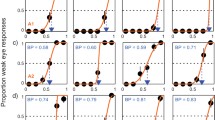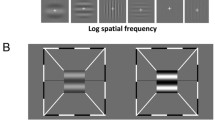Abstract
The monocular contrast sensitivity loss in amblyopia is well documented. We investigated the influence of interocular sensitivity difference on binocular contrast sensitivity in amblyopia. Monocular and binocular contrast sensitivity functions of six amblyopes (three strabismic and three anisometropic) were measured. The monocular contrast sensitivity loss depended on the type of amblyope. Anisometropic amblyopes generally showed high frequency losses. Strabismic amblyopes showed losses at both low and high spatial frequencies. Binocular performance was assessed in terms of binocular ratios (binocular/non-amblyopic). A binocular ratio greater than 1 indicates binocular summation (binocular > monocular) while a ratio less than 1 shows binocular inhibition (binocular < monocular). In all subjects, the binocular ratio depended on the difference between the amblyopic and the non-amblyopic eye. Minimal interocular difference produced binocular summation, the magnitude of which decreased as the difference between the two eyes increased. Further increases in the monocular difference produced binocular inhibition. Anisometropic amblyopes showed a greater degree of binocular summation at low spatial frequencies compared to strabismic amblyopes. Both types of amblyopes showed binocular inhibition at high spatial frequencies. Clinical implications of binocular summation and inhibition in amblyopia are discussed.
Similar content being viewed by others
References
Gstalder RJ, Green DG. Laser interferometric acuity in amblyopia. J Pediatr Ophthalmol 1971; 8: 251–56.
Thomas J. Normal and amblyopic contrast sensitivity functions in central and peripheral retinas. Invest Ophthal Vis Sci 1978; 17: 746–53.
Yap M. Clinical application of contrast sensitivity in visual dysfunction. PhD Thesis, University of Bradford, 1985.
Bradley A, Freeman RD. Contrast sensitivity in anisometropic amblyopia. Invest Ophthal Vis Sci 1981; 21: 467–76.
Hess R, Howell ER. The threshold contrast sensitivity function in strabismic amblyopia, independence for two type classification. Vis Res 1977; 17: 1049–55.
Hess R, Campbell F, Zimmerman R. Differences in the neural basis of human amblyopias: The effect of mean luminance. Vis Res 1980; 20: 295–305.
Ziel C, Schmeisser E. Flicker VEP in amblyopes. Invest Ophthalmol Vis Sci (Suppl) 1990; 31: 605.
Blake R, Fox R. The psychophysical inquiry into binocular summation. Percept Psychophysics 1973; 14: 161–85.
Blake R, Sloane M, Fox R. Further developments in binocular summation. Percept Psychophysics 1981; 30: 266–76.
Campbell F, Green D. Monocular versus binocular visual acuity. Nature 1965; 208: 191–92.
Eriksen C. Independence of successive inputs and uncorrelated error in visual form perception. J Exp Psychol 1966; 72: 26–35.
Lema SA, Blake R. Binocular summation in normal and stereoblind humans. Vis Res 1977; 17: 691–95.
Sireteanu R. Binocular luminance summation in humans with defective binocular vision. Invest Ophthal Vis Sci 1987; 28: 349–55.
Sireteanu R, Altman I. Binocular luminance summation in young kittens and adult strabismic cats. Invest Ophthal Vis Sci 1987; 28: 343–48.
Blake R, Martens W, Gianfilippo AD. Reaction time as a measure of binocular interaction in human vision. Invest Ophthal Vis Sci 1980; 19: 930–41.
Levi D, Harwerth R, Manny R. Suprathreshold spatial frequency detection and binocular interaction in strabismic and anisometropic amblyopia. Invest Ophthal Vis Sci 1979; 18: 714–25.
Birch E, Held R. The development of binocular summation in human infants. Invest Ophthal Vis Sci 1983; 24: 1103.
Sireteanu R, Fronius M, Singer W. Binocular interactions in the peripheral visual fields of humans with strabismic and anisometropic amblyopia. Vis Res 1981; 21: 1065–74.
Shea SL, Doussard-Roosevelt JA, Aslin RH. Pupillary measurements of binocular luminance summation in infants and stereoblind adults. Invest Ophthal Vis Sci 1985; 26: 1064.
Shea SL, Aslin RH, McCulloch. Binocular VEP summation in infants and adults with abnormal binocular histories. Invest Ophthal Vis Sci 1987; 28: 356–65.
Holopigian K, Blake R, Greenwald M. Selective losses in binocular vision in anisometropic amblyopes. Vis Res 1986; 26: 621–30.
Pardhan S, Gilchrist J. The effect of monocular defocus on binocular contrast sensitivity. Ophth Physiol Opt 1990; 10: 33–36.
Pardhan S, Gilchrist J. Binocular contrast sensitivity with monocular glare disability. Ophth Physiol Opt 1990; 10: 37–39.
Pardhan S, Gilchrist J. The importance of measuring binocular contrast sensitivity in unilateral cataract. Eye 1991; 5: 31–35.
Watson A, Pelli D. QUEST: A Bayesian adaptive psychometric method. Percept Psychophysics 1983; 33: 113–20.
Smith EL, Levi DM, Manny RE, Harwerth RS, White JM. The relationship between binocular rivalry and strabismic suppression. Invest Ophthal Vis Sci 1985; 26: 80.
Movshon JA, Chambers BE, Blakemore C. Interocular transfer in normal humans and those who lack stereopsis. Perception 1972; 1: 483–90.
Mitchell DE, Reardon J, Muir DW. Interocular transfer of the motion aftereffect in normal and stereoblind observers. Exp Brain Res 1975; 22: 535–58.
Wade NJ. On interocular transfer of the movement aftereffect in individuals with and without normal binocular vision. Perception 1976; 5: 113.
Levi D, Harweth R, Smith E. Humans deprived of normal binocular vision have binocular interactions tuned to size and orientation. Science 1979; 206: 852–54.
Levi D, Pass A, Manny A. Binocular interactions in normal and anomalous binocular vision: The effects of flicker. Br J Ophthal 1982; 66: 57–63.
Harwerth R, Levi D. Psychophysical studies of binocular processes of amblyopes. Am J Optom Phys Opt 1983; 60: 454–63.
Harrad RA, Hess R. Threshold conditions for strabismic suppression and binocular rivalry in amblyopia. Invest Ophthal Vis Sci (Suppl) 1990; 31: 305.
Holopigian K, Blake R, Greenwald M. Clinical suppression and amblyopia. Invest Ophthal Vis Sci 1988; 29: 444–51.
Selby SA, Woodhouse JM. The spatial frequency dependence of interocular transfer of amblyopes. Vis Res 1981; 21: 1401–08.
Author information
Authors and Affiliations
Rights and permissions
About this article
Cite this article
Pardhan, S., Gilchrist, J. Binocular contrast summation and inhibition in amblyopia. Doc Ophthalmol 82, 239–248 (1992). https://doi.org/10.1007/BF00160771
Accepted:
Issue Date:
DOI: https://doi.org/10.1007/BF00160771




